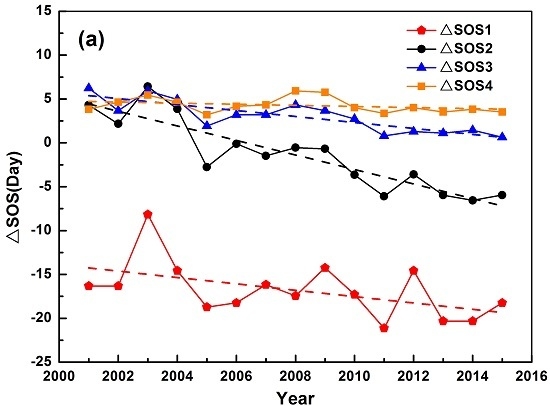Investigation of Urbanization Effects on Land Surface Phenology in Northeast China during 2001–2015
Abstract
:1. Introduction
2. Materials and Methods
2.1. Study Area
2.2. Land Cover Data
2.3. MODIS EVI Data
2.4. MODIS LST Data
2.5. Phenology Metrics
2.6. Calculation of UELSP and UHII
3. Results
3.1. Mean Phenology and Mean LST in Northeast China
3.2. Temporal Variations of UELSP
3.3. Temporal Variations of UHII
3.4. Correlations between UHII and UELSP
4. Discussion
4.1. Mean UHII and LSP
4.2. Temporal Variations of UHII and UELSP in Addition to Possible Reasons
4.3. Relationships between UHII and UELSP
4.4. Uncertainty
5. Conclusions
Acknowledgments
Author Contributions
Conflicts of Interest
References
- Mimet, A.; Pellissier, V.; Quénol, H.; Aguejdad, R.; Dubreuil, V.; Rozé, F. Urbanisation induces early flowering: evidence from Platanus acerifolia and Prunus cerasus. Int. J. Biometeorol. 2009, 53, 287–298. [Google Scholar] [CrossRef] [PubMed]
- United Nation Population Division. Available online: https://esa.un.org/unpd/wup/DataQuery/ (accessed on 30 October 2016).
- Krehbiel, C.P.; Jackson, T.; Henebry, G.M. Web-Enabled Landsat data time series for monitoring urban heat island impacts on land surface phenology. IEEE J. Sel. Top. Appl. Earth Obs. Remote Sens. 2016, 9, 2043–2050. [Google Scholar] [CrossRef]
- Zhou, D.; Zhao, S.; Zhang, L.; Liu, S. Remotely sensed assessment of urbanization effects on vegetation phenology in China’s 32 major cities. Remote Sens. Environ. 2016, 176, 272–281. [Google Scholar] [CrossRef]
- Zhou, D.; Zhao, S.; Zhang, L.; Sun, G.; Liu, Y. The footprint of urban heat island effect in China. Sci. Rep. 2015, 5, 11160. [Google Scholar] [CrossRef] [PubMed]
- Peng, S.; Piao, S.; Ciais, P.; Friedlingstein, P.; Ottle, C.; Bréon, F.; Nan, H.; Zhou, L.; Myneni, R.B. Surface urban heat island across 419 global big cities. Environ. Sci. Technol. 2012, 46, 696–703. [Google Scholar] [CrossRef]
- Zhou, D.; Zhao, S.; Liu, S.; Zhang, L.; Zhu, C. Surface urban heat island in China’s 32 major cities: Spatial patterns and drivers. Remote Sens. Environ. 2014, 152, 51–61. [Google Scholar] [CrossRef]
- Clinton, N.; Gong, P. MODIS detected surface urban heat islands and sinks: Global locations and controls. Remote Sens. Environ. 2013, 134, 294–304. [Google Scholar] [CrossRef]
- Arnfield, A.J. Two decades of urban climate research: a review of turbulence, exchanges of energy and water, and the urban heat island. Int. J. Climatol. 2003, 23, 1–26. [Google Scholar] [CrossRef]
- Kang, X.; Hao, Y.; Cui, X.; Chen, H.; Huang, S.; Du, Y.; Li, W.; Kardol, P.; Xiao, X.; Cui, L. Variability and changes in climate, phenology, and gross primary production of an Alpine wetland ecosystem. Remote Sens. 2016, 8, 391. [Google Scholar] [CrossRef]
- Cecchi, L.; d’Amato, G.; Ayres, J.; Galan, C.; Forastiere, F.; Forsberg, B.; Gerritsen, J.; Nunes, C.; Behrendt, H.; Akdis, C. Projections of the effects of climate change on allergic asthma: The contribution of aerobiology. Allergy 2010, 65, 1073–1081. [Google Scholar] [CrossRef] [PubMed]
- Van Vliet, A.J.; Overeem, A.; de Groot, R.S.; Jacobs, A.F.; Spieksma, F. The influence of temperature and climate change on the timing of pollen release in the Netherlands. Int. J. Climatol. 2002, 22, 1757–1767. [Google Scholar] [CrossRef]
- Zhao, J.; Wang, Y.; Zhang, Z.; Zhang, H.; Guo, X.; Yu, S.; Du, W.; Huang, F. The variations of land surface phenology in Northeast China and its responses to climate change from 1982 to 2013. Remote Sens. 2016, 8, 400. [Google Scholar] [CrossRef]
- Liang, S.; Shi, P.; Li, H. Urban spring phenology in the middle temperate zone of China: Dynamics and influence factors. Int. J. Biometeorol. 2016, 60, 531–544. [Google Scholar] [CrossRef] [PubMed]
- Wu, C.; Hou, X.; Peng, D.; Gonsamo, A.; Xu, S. Land surface phenology of China’s temperate ecosystems over1999–2013: Spatial–temporal patterns, interaction effects, covariation with climate and implications for productivity. Agric. For. Meteorol. 2016, 216, 177–187. [Google Scholar] [CrossRef]
- Han, G.; Xu, J. Land surface phenology and land surface temperature changes along an urban–rural gradient in Yangtze River Delta, China. Environ. Manag. 2013, 52, 234–249. [Google Scholar] [CrossRef]
- Buyantuyev, A.; Wu, J. Urbanization diversifies land surface phenology in arid environments: Interactions among vegetation, climatic variation, and land use pattern in the Phoenix metropolitan region, USA. Landsc. Urban Plan. 2012, 105, 149–159. [Google Scholar] [CrossRef]
- White, M.A.; Nemani, R.R.; Thornton, P.E.; Running, S.W. Satellite evidence of phenological differences between urbanized and rural areas of the eastern United States deciduous broadleaf forest. Ecosystems 2002, 5, 260–277. [Google Scholar] [CrossRef]
- Dallimer, M.; Tang, Z.; Gaston, K.J.; Davies, Z.G. The extent of shifts in LSP between rural and urban areas within a human-dominated region. Ecol. Evol. 2016, 6, 1942–1953. [Google Scholar] [CrossRef] [PubMed]
- Jochner, S.C.; Sparks, T.H.; Estrella, N.; Menzel, A. The influence of altitude and urbanization trends and mean dates in phenology (1980–2009). Int. J. Biometeorol. 2012, 56, 387–394. [Google Scholar] [CrossRef] [PubMed]
- Gazal, R.; White, M.A.; Gillies, R.; Rodemaker, E.; Sparrow, E.; Gordon, L. GLOBE students, teachers, and scientists demonstrate variable differences between urban and rural leaf phenology. Glob. Chang. Biol. 2008, 14, 1568–1580. [Google Scholar] [CrossRef]
- Neil, K.; Wu, J. Effects of urbanization on plant flowering phenology: A review. Urban Ecosyst. 2006, 9, 243–257. [Google Scholar] [CrossRef]
- Luo, Z.; Sun, O.J.; Ge, Q.; Xu, W.; Zheng, J. Phenological responses of plants to climate change in an urban environment. Ecol. Res. 2007, 22, 507–514. [Google Scholar] [CrossRef]
- Liu, S.; Zhang, P.; Wang, Z.; Liu, W.; Tan, J. Measuring the sustainable urbanization potential of cities in Northeast China. J. Geogr. Sci. 2016, 26, 549–567. [Google Scholar] [CrossRef]
- Liu, J.; Kuang, W.; Zhang, Z.; Xu, X.; Qin, Y.; Ning, J.; Zhou, W.; Zhang, S.; Li, R.; Yan, C.; et al. Spatiotemporal characteristics, patterns, and causes of land-use changes in China since the late 1980s. J. Geogr. Sci. 2014, 24, 195–210. [Google Scholar] [CrossRef]
- Liu, J.; Zhang, Z.; Xu, X.; Kuang, W.; Zhou, W.; Zhang, S.; Li, R.; Yan, C.; Yu, D.; Wu, S.; Jiang, N. Spatial patterns and driving forces of land use change in China during the early 21st century. J. Geogr. Sci. 2010, 20, 483–494. [Google Scholar] [CrossRef]
- Liu, J.; Liu, M.; Zhuang, D.; Zhang, Z.; Deng, X. Study on spatial pattern of land-use change in China during 1995–2000. Sci. China Ser. D 2003, 46, 373–384. [Google Scholar]
- Kuang, W.; Liu, J.; Dong, J.; Chi, W.; Zhang, C. The rapid and massive urban and industrial land expansions in China between 1990 and 2010: A CLUD-based analysis of their trajectories, patterns, and drivers. Landsc. Urban Plan. 2016, 145, 21–33. [Google Scholar] [CrossRef]
- Huete, A.; Didan, K.; Miura, T.; Rodriguez, E.P.; Gao, X.; Ferreira, L.G. Overview of the radiometric and biophysical performance of the MODIS vegetation indices. Remote Sens. Environ. 2002, 83, 195–213. [Google Scholar] [CrossRef]
- Ishtiaque, A.; Myint, S.W.; Wang, C. Examining the ecosystem health and sustainability of the world’s largest mangrove forest using multi-temporal MODIS products. Sci. Total Environ. 2016, 569, 1241–1254. [Google Scholar] [CrossRef] [PubMed]
- Zhang, X.; Friedl, M.A.; Schaaf, C.B.; Strahler, A.H.; Schneider, A. The footprint of urban climates on vegetation phenology. Geophys. Res. Lett. 2004, 31. [Google Scholar] [CrossRef]
- Dallimer, M.; Tang, Z.; Bibby, P.R.; Brindley, P.; Gaston, K.J.; Davies, Z.G. Temporal changes in green space in a highly urbanized region. Biol. Lett. 2011, 7, 763–766. [Google Scholar] [CrossRef] [PubMed]
- Zhou, D.; Zhao, S.; Liu, S.; Zhang, L. Spatiotemporal trends of terrestrial vegetation activity along the urban development intensity gradient in China’s 32 major cities. Sci. Total Environ. 2014, 488, 136–145. [Google Scholar] [CrossRef] [PubMed]
- LPDAAC (Land Processes Distributed Active Archive Center). MODIS Reprojection Tool. Available online: https://lpdaac.usgs.gov/tools/modis_reprojection_tool (accessed on 7 July 2014).
- Qiao, Z.; Tian, G.; Xiao, L. Diurnal and seasonal impacts of urbanization on the urban thermal environment: A case study of Beijing using MODIS data. ISPRS. J. Photogramm. 2013, 85, 93–101. [Google Scholar] [CrossRef]
- Jin, M.; Dickinson, R.E.; Zhang, D. The footprint of urban areas on global climate as characterized by MODIS. J. Clim. 2005, 18, 1551–1565. [Google Scholar] [CrossRef]
- Hung, T.; Uchihama, D.; Ochi, S.; Yasuoka, Y. Assessment with satellite data of the urban heat island effects in Asian mega cities. Int. J. Appl. Earth. Obs. 2006, 8, 34–48. [Google Scholar]
- Pongracz, R.; Bartholy, J.; Dezso, Z. Remotely sensed thermal information applied to urban climate analysis. Adv. Space Res. 2006, 37, 2191–2196. [Google Scholar] [CrossRef]
- Wan, Z. New refinements and validation of the MODIS land-surface temperature/emissivity products. Remote Sens. Environ. 2008, 112, 59–74. [Google Scholar] [CrossRef]
- Pablos, M.; Martínez-Fernández, J.; Piles, M.; Sánchez, N.; Vall-llossera, M.; Camps, A. Multi-temporal evaluation of soil moisture and land surface temperature dynamics using in situ and satellite observations. Remote Sens. 2016, 8, 587. [Google Scholar] [CrossRef]
- Gow, L.J.; Barret, D.J.; Renzullo, L.J.; Phinn, S.R.; O’Grady, A.P. Characterising groundwater use by vegetation using a surface energy balance model and satellite observations of land surface temperature. Environ. Model. Softw. 2016, 80, 66–82. [Google Scholar] [CrossRef]
- Chen, J.; Jönsson, P.; Tamura, M.; Gu, Z.; Matsushita, B.; Eklundh, L. A simple method for reconstructing a high-quality NDVI time-series data set based on the Savitzky–Golay filter. Remote Sens. Environ. 2004, 91, 332–344. [Google Scholar] [CrossRef]
- Jönsson, P.; Eklundh, L. TIMESAT—A program for analyzing time-series of satellite sensor data. Comput. Geosci. 2004, 30, 833–845. [Google Scholar] [CrossRef]
- Chu, L.; Liu, Q.; Huang, C.; Liu, G. Monitoring of winter wheat distribution and phenological phases based on MODIS time-series: A case study in the Yellow River Delta, China. J. Integr. Agric. 2016, 15, 60345–60347. [Google Scholar] [CrossRef]
- Yu, X.; Zhuang, D. Monitoring forest phenophases of Northeast China based on MODIS NDVI data. Resour. Sci. 2006, 28, 111–117. [Google Scholar]
- Hou, X.H.; Niu, Z.; Gao, S. Phenology of forest vegetation in northeast of China in ten years using remote sensing. Spectrosc. Spectr. Anal. 2014, 34, 515–519. [Google Scholar]
- Yu, X.; Wang, Q.; Yan, H.; Wang, Y.; Wen, K.; Zhuang, D.; Wang, Q. Forest phenology dynamics and its responses to meteorological variations in Northeast China. Adv. Meteorol. 2014, 2014, 592106. [Google Scholar] [CrossRef]
- Wang, J.; Huang, B.; Fu, D.; Atkinson, P.M. Spatiotemporal variation in surface urban heat island intensity and associated determinants across major Chinese cities. Remote Sens. 2015, 7, 3670–3689. [Google Scholar] [CrossRef]
- Wang, C.; Myint, S.W.; Wang, Z.; Song, J. Spatio-temporal modeling of the urban heat island in the phoenix metropolitan area: Land use change implications. Remote. Sens. 2016, 8, 185. [Google Scholar] [CrossRef]
- Yuan, F.; Bauer, M.E. Comparison of impervious surface area and normalized difference vegetation index as indicators of surface urban heat island effects in Landsat imagery. Remote Sens. Environ. 2007, 106, 375–386. [Google Scholar] [CrossRef]
- Rosenfeld, A.H.; Akbari, H.; Bretz, S.; Fishman, B.L.; Kurn, D.M.; Sailor, D.; Taha, H. Mitigation of urban heat islands: Materials, utility programs, updates. Energy Build. 1995, 22, 255–265. [Google Scholar] [CrossRef]
- Ca, V.T.; Asaeda, T.; Abu, E.M. Reductions in air-conditioning energy caused by a nearby park. Energy Build. 1998, 29, 83–92. [Google Scholar] [CrossRef]
- Ashie, Y.; Thanh, V.C.; Asaeda, T. Building canopy model for the analysis of urban climate. J. Wind Eng. Ind. Aerodrn. 1999, 81, 237–248. [Google Scholar] [CrossRef]
- Tong, H.; Walton, A.; Sang, J.; Chan, J.C.L. Numerical simulation of the urban boundary layer over the complex terrain of Hong Kong. Atmos. Environ. 2005, 39, 3549–3563. [Google Scholar] [CrossRef]
- Yu, C.; Hien, W.N. Thermal benefits of city parks. Energy Build. 2006, 38, 105–120. [Google Scholar] [CrossRef]
- Myint, S.W.; Wentz, E.A.; Brazel, A.J.; Quattrochi, D.A. The impact of distinct anthropogenic and vegetation features on urban warming. Landsc. Ecol. 2013, 28, 959–978. [Google Scholar] [CrossRef]
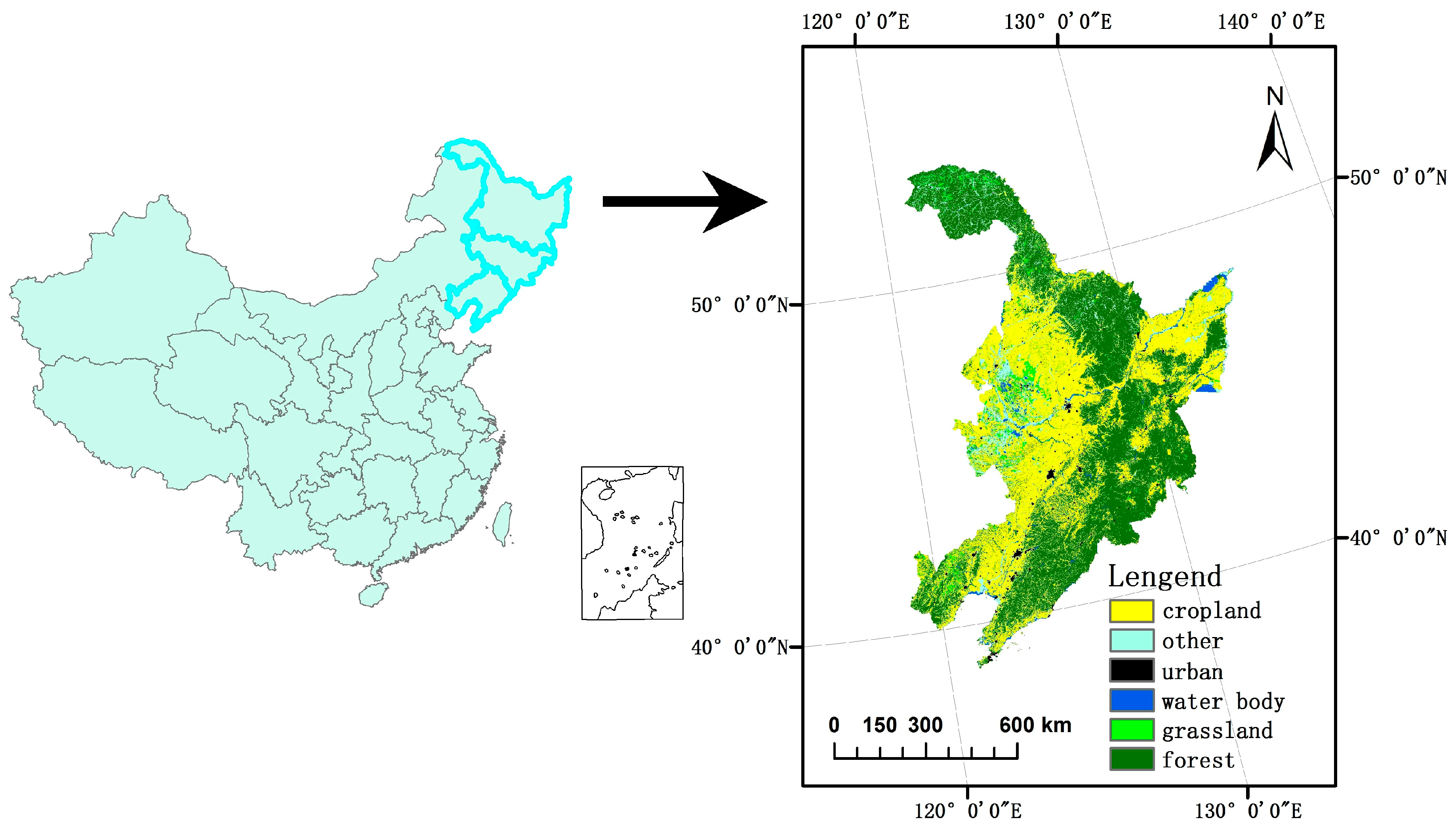
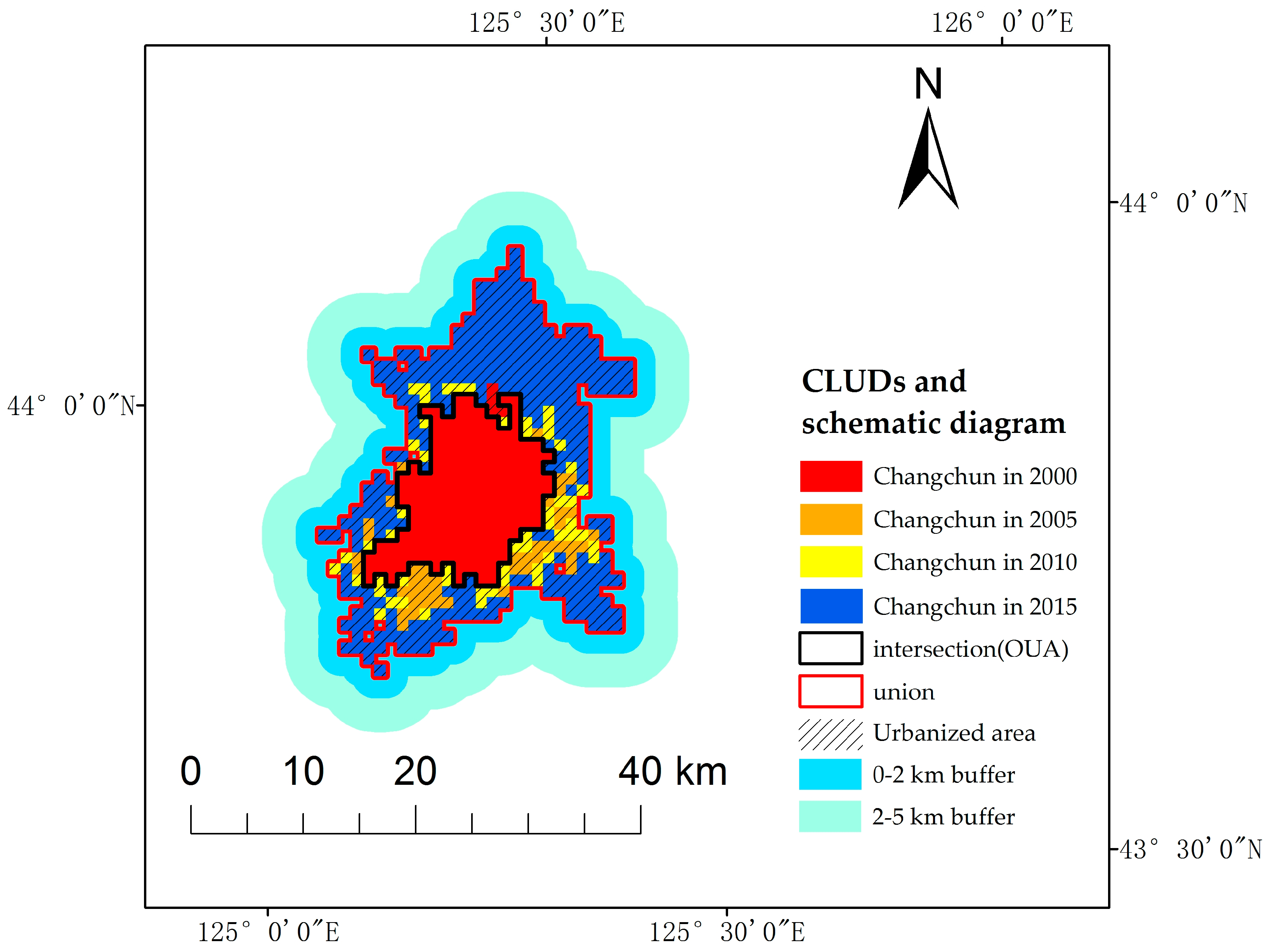
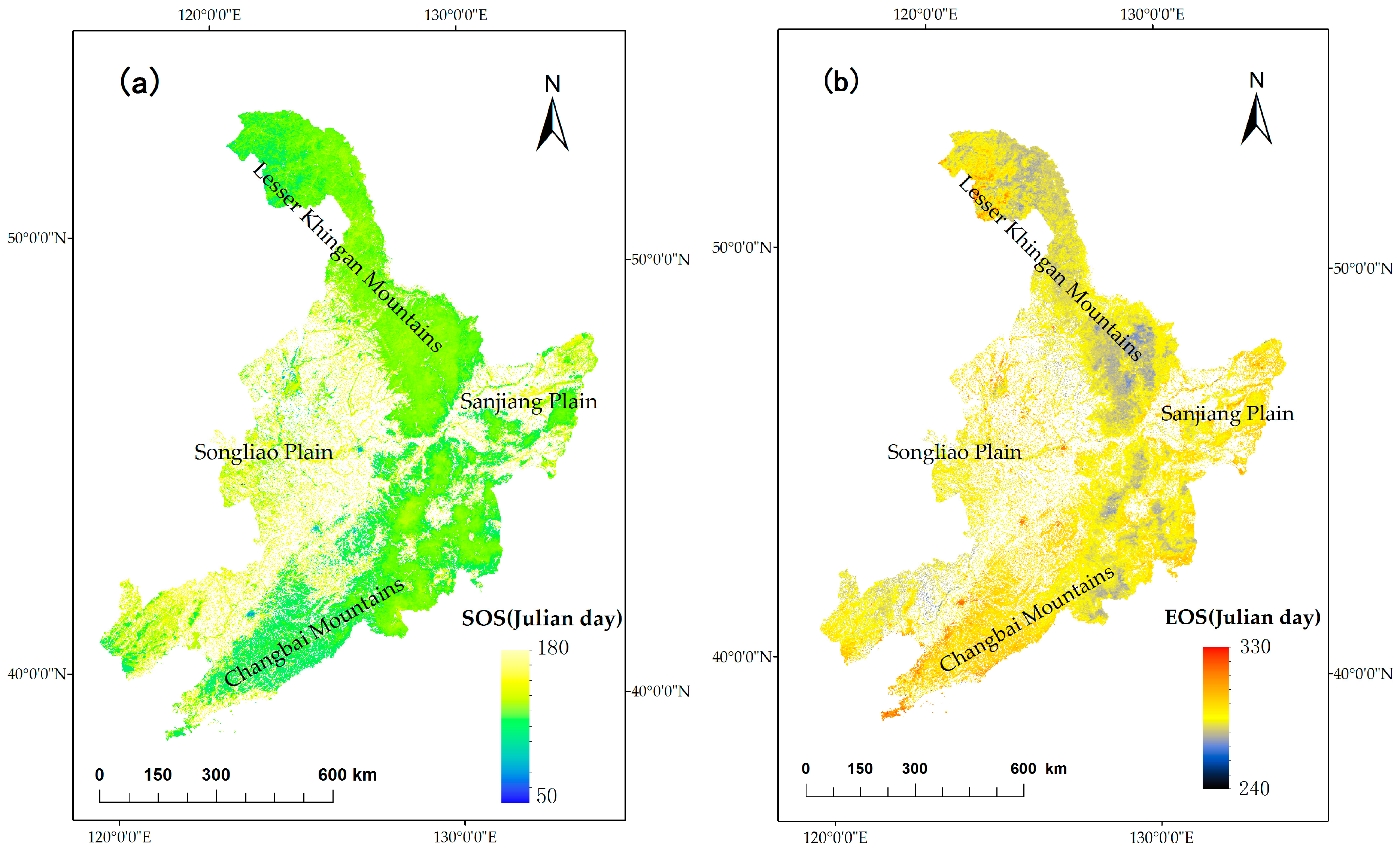
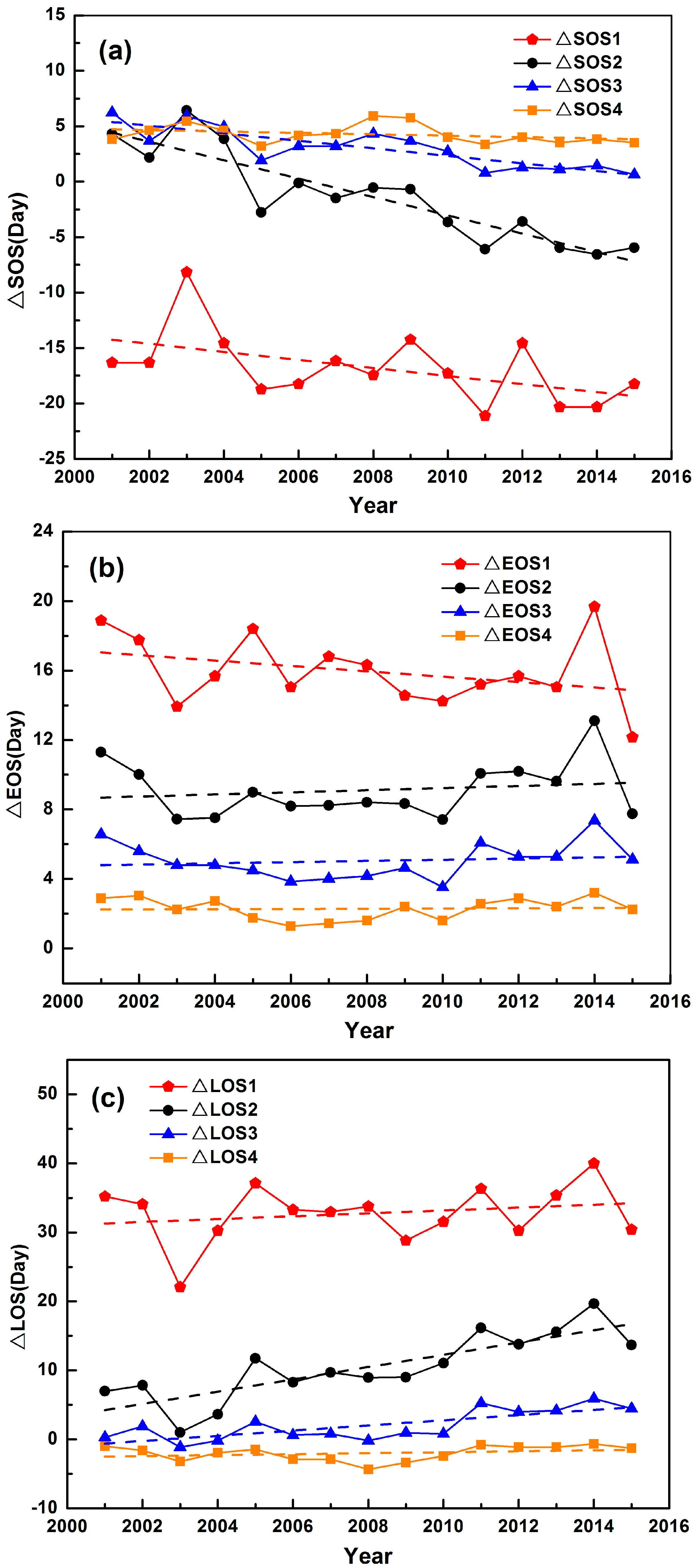
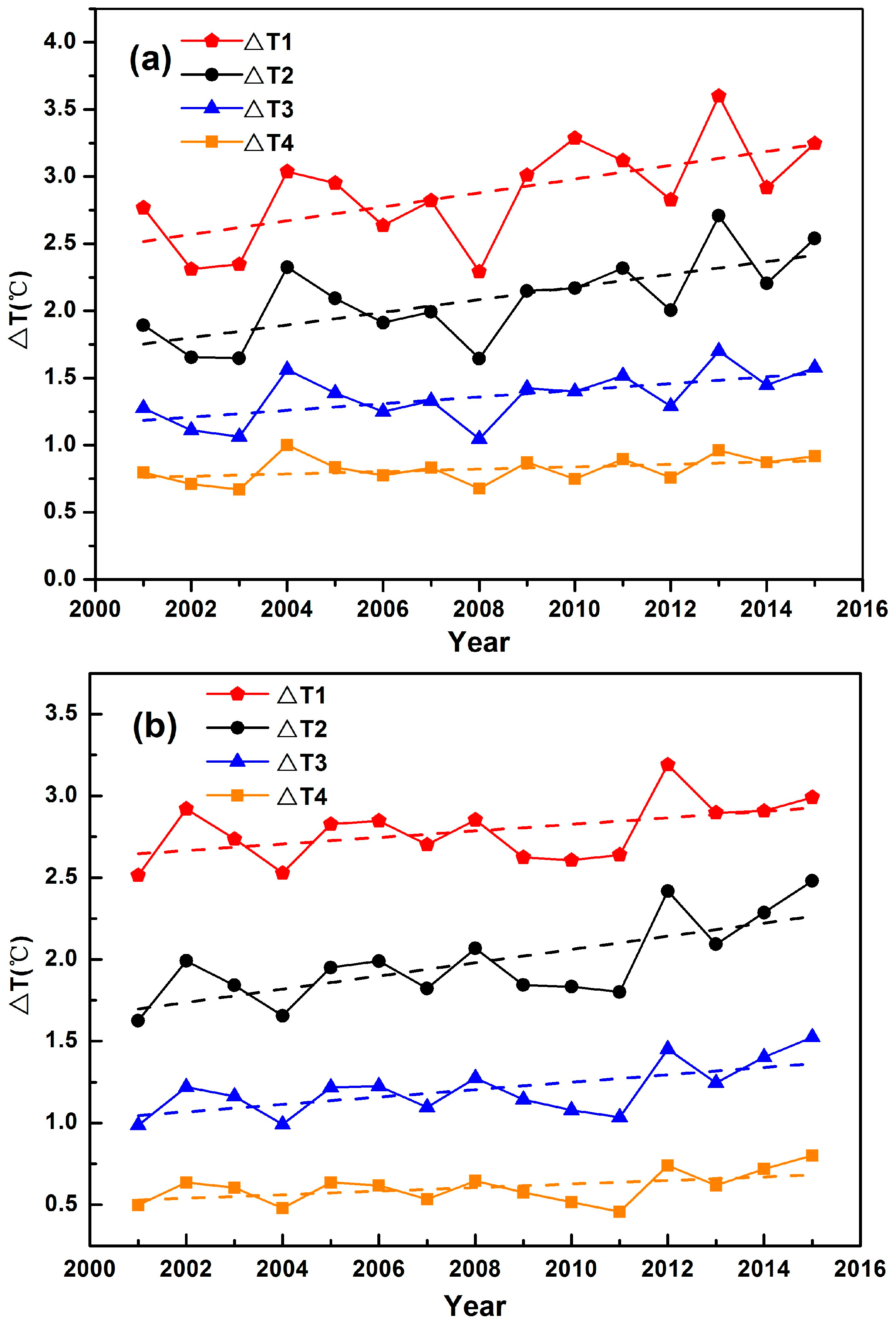
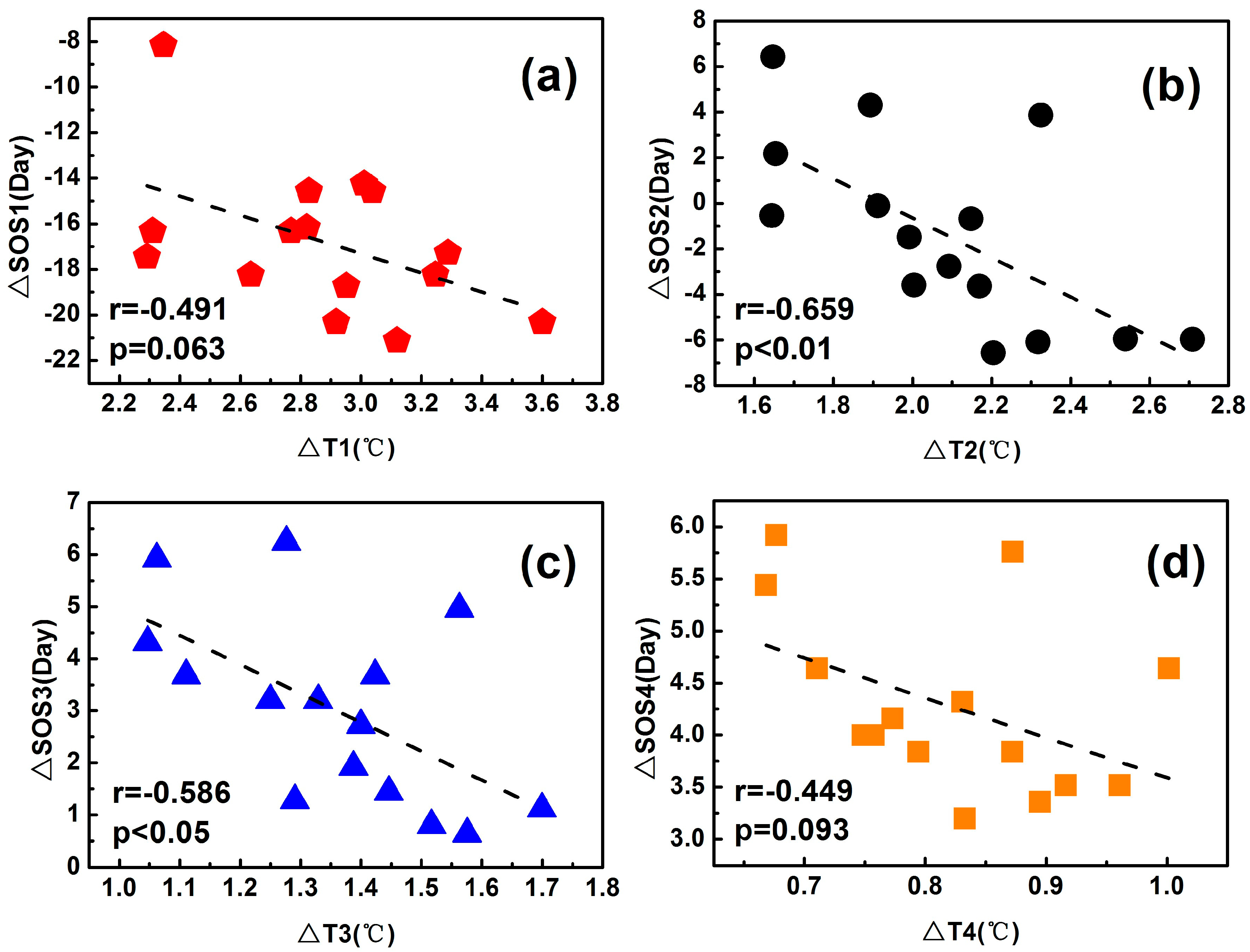

| SOS(DOY) | EOS(DOY) | LOS(DOY) | Spring LST (°C) | Autumn LST (°C) | |
|---|---|---|---|---|---|
| Entire study area | |||||
| OUAs | 115.61 | 305.15 | 189.54 | 10.87 | 10.07 |
| urbanized areas | 131.03 | 298.31 | 167.28 | 10.08 | 9.26 |
| 0–2 km buffer | 135.41 | 294.23 | 158.82 | 9.21 | 8.48 |
| 2–5 km buffer | 136.68 | 291.48 | 154.8 | 8.81 | 7.88 |
| 20–25 km buffer | 132.41 | 289.19 | 156.78 | 7.99 | 7.28 |
| Heilongjiang province | |||||
| OUAs | 115.66 | 304.35 | 188.69 | 8.38 | 6.91 |
| urbanized area | 133.21 | 296.30 | 163.09 | 7.62 | 6.25 |
| 0–2 km buffer | 139.11 | 292.46 | 153.35 | 6.81 | 5.65 |
| 2–5 km buffer | 139.43 | 290.52 | 151.09 | 6.28 | 5.28 |
| 20–25 km buffer | 133.25 | 287.06 | 153.81 | 5.59 | 4.9 |
| Jilin province | |||||
| OUAs | 114.01 | 304.5 | 190.49 | 10.04 | 9.03 |
| urbanized areas | 130.40 | 297.00 | 166.6 | 9.22 | 8.18 |
| 0–2 km buffer | 135.67 | 291.54 | 155.87 | 8.68 | 7.61 |
| 2–5 km buffer | 137.15 | 289.28 | 152.13 | 8.45 | 7.30 |
| 20–25 km buffer | 132.73 | 289.3 | 156.57 | 8.02 | 7.26 |
| Liaoning province | |||||
| OUAs | 116.18 | 305.88 | 189.7 | 12.87 | 12.75 |
| urbanized areas | 129.3 | 300.14 | 170.84 | 12.11 | 11.87 |
| 0–2 km buffer | 133.72 | 296.32 | 162.6 | 11.49 | 11.05 |
| 2–5 km buffer | 134.9 | 293.49 | 158.59 | 11.18 | 10.59 |
| 20–25 km buffer | 131.31 | 291.07 | 159.76 | 11.01 | 10.44 |
| This Study | Zhao et al. [14] | Yu et al. [44] | Hou et al. [45] | Yu et al. [46] | |
|---|---|---|---|---|---|
| SOS of entire study area (Jlian day) | 112–161 | 110–150 | |||
| EOS of entire study area (Jlian day) | 273–300 | 270–320 | |||
| SOS of forest (Jlian day) | 113–151 | 100–150 | 110–140 | 100–140 | |
| EOS of forest (Jlian day) | 273–299 | 260–290 | 260–290 | 265–300 | |
| Time period (year) | 2001–2015 | 1982–2013 | 2003 | 2001–2010 | 2000–2009 |
| ∆SOS | ∆EOS | ∆LOS | ∆T in Spring | ∆T in Autumn | |
|---|---|---|---|---|---|
| OUAs | −0.363 | −0.155 | 0.208 | 0.052 * | 0.02 |
| urbanized areas | −0.829 ** | 0.061 | 0.89 ** | 0.047 ** | 0.04 ** |
| 0–2 km buffer | −0.34 ** | 0.034 | 0.374 ** | 0.025 * | 0.023 * |
| 2–5 km buffer | −0.063 | 0.007 | 0.07 | 0.009 | 0.011 |
© 2017 by the authors; licensee MDPI, Basel, Switzerland. This article is an open access article distributed under the terms and conditions of the Creative Commons Attribution (CC-BY) license (http://creativecommons.org/licenses/by/4.0/).
Share and Cite
Yao, R.; Wang, L.; Huang, X.; Guo, X.; Niu, Z.; Liu, H. Investigation of Urbanization Effects on Land Surface Phenology in Northeast China during 2001–2015. Remote Sens. 2017, 9, 66. https://doi.org/10.3390/rs9010066
Yao R, Wang L, Huang X, Guo X, Niu Z, Liu H. Investigation of Urbanization Effects on Land Surface Phenology in Northeast China during 2001–2015. Remote Sensing. 2017; 9(1):66. https://doi.org/10.3390/rs9010066
Chicago/Turabian StyleYao, Rui, Lunche Wang, Xin Huang, Xian Guo, Zigeng Niu, and Hongfu Liu. 2017. "Investigation of Urbanization Effects on Land Surface Phenology in Northeast China during 2001–2015" Remote Sensing 9, no. 1: 66. https://doi.org/10.3390/rs9010066





